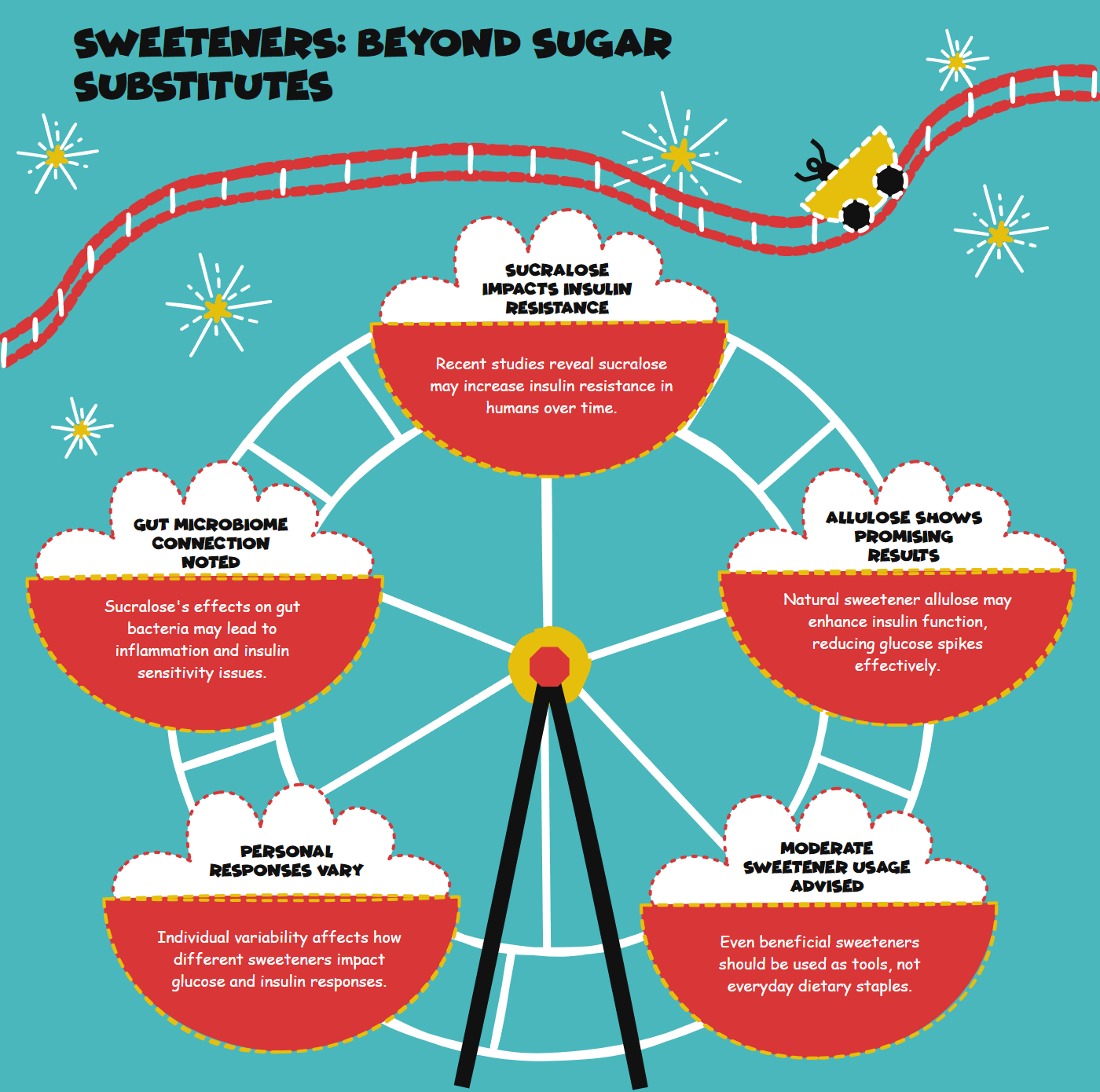
The Metabolic Truth About Sucralose Finally Revealed
The Metabolic Truth About Sucralose Finally Revealed
That little yellow packet of sucralose in your coffee might not be the metabolic freebie we've all been led to believe. Artificial sweeteners have been marketed as guilt-free alternatives to sugar, providing sweetness without calories or glycemic impact for years. However, recent research has unveiled a more concerning reality.
I've been tracking emerging studies on non-nutritive sweeteners, and what I'm seeing challenges everything we thought we knew about these popular sugar substitutes.
The Insulin Resistance Revelation
Let's cut to the chase: sucralose isn't metabolically inert. New human studies show that it may increase insulin resistance over time, confirming what rodent research has suggested for years.
For too long, we dismissed animal studies showing dysglycemia and glucose spikes after chronic sucralose exposure, assuming these findings wouldn't translate to humans. We were wrong.
Multiple gold-standard insulin clamp studies now demonstrate increased insulin resistance in human subjects consuming sucralose, even at doses consistent with regular use. This isn't theoretical anymore – it's happening to real people.
What's particularly alarming is how these findings align with what researchers have observed in rodents for years. The scientific community ignored those warning signs, assuming human metabolism would respond differently. The evidence now suggests otherwise.
The Microbiome Connection
So how does a non-caloric sweetener trigger insulin resistance? The leading hypothesis points to our gut bacteria.
Sucralose appears to alter the composition of the gut microbiome, which can trigger cascading effects throughout the body, including inflammation, disrupted glucose regulation, and impaired insulin sensitivity.
This mechanism remains somewhat hypothetical, but the metabolic effects are increasingly well-documented. And they're concerning.
What's more troubling is that combining sucralose with actual sugar–like a diet soda with a carb-heavy meal–may amplify glycemic spikes beyond what either would cause alone. This synergistic effect could worsen metabolic dysfunction in people regularly consuming both.
Not All Sweeteners Are Created Equal
The story changes dramatically when we look beyond artificial sweeteners to natural alternatives. The emerging data creates a fascinating contrast.
While sucralose and aspartame raise metabolic concerns, natural non-caloric sweeteners like stevia, monk fruit, and especially allulose show neutral or potentially beneficial effects.
Allulose stands out as particularly promising. Derived from fructose but altered at the third carbon position (making it a C3 epimer), allulose delivers sweetness with minimal calories and – surprisingly – potential metabolic benefits.
Both animal and human studies suggest allulose enhances GLP-1 secretion (a hormone that improves insulin function), reduces glucagon levels, and slows gastric emptying – all effects that help blunt post-meal blood sugar spikes.
These properties could be game-changing for people with diabetes. Early evidence suggests that allulose may reduce overall insulin requirements in people with Type 1 diabetes and improve glucose control in those with Type 2.
Personal Evidence
The clinical data is compelling, but anecdotal evidence adds another layer of intrigue.
Dr. Kutnick, a Type 1 diabetic who has closely monitored his glucose response to various sweeteners, found that co-administering allulose with meals significantly lowered his glucose spikes and reduced insulin needs. His personal experiments suggest potential benefits even during fasting periods, due to allulose's minimal insulin response.
Similarly interesting is the observation that monk fruit, in its pure form, causes glucose drops into the 30s in highly insulin-sensitive individuals, suggesting it might trigger some insulin response despite being categorized as non-insulinogenic.
These observations highlight an important point: individual responses to sweeteners vary considerably. What works for one person may not work for another.
Media Misrepresentation and The Erythritol Panic
The sweetener conversation became even more muddled last year when a high-profile study linked blood erythritol levels to cardiovascular events and mortality. The media headlines were alarming, but the actual science deserved more careful interpretation.
The study measured endogenous erythritol, which the body naturally produces, not from consumption. People with metabolic syndrome naturally produce more erythritol via the Pentose Phosphate Pathway, making high erythritol a potential marker of metabolic dysfunction rather than its cause.
No causation was established between erythritol consumption and heart disease, and the study didn't directly test erythritol in humans. Yet headlines suggested we should immediately throw out this sweetener.
This illustrates a broader problem: the disconnect between nuanced scientific findings and their representation in media. As consumers and clinicians, we must maintain critical thinking when evaluating study quality and media interpretations.
The Fasting Question
A common question in health circles is whether various sweeteners "break a fast." The answer depends entirely on how you define fasting.
Given its minimal insulin response, allulose might support your fast if your goal is to keep insulin levels low. If you're aiming for zero caloric or metabolic input, then technically, it might break the fast, though its impact is minimal.
This highlights the importance of clearly defining your goals. The concept of "breaking a fast" isn't binary—it's contextual.
The Path Forward
So where does this leave us? With several important takeaways:
First, not all sweeteners are metabolically inert. Artificial options like sucralose, once believed to be harmless sugar substitutes, may pose real risks to metabolic health with chronic use.
Second, natural sweeteners, especially allulose, are showing potential therapeutic benefits for those with insulin resistance or diabetes, making them not just "less bad" alternatives to sugar, but potentially beneficial tools.
Third, personalized response matters. Individual genetics, gut microbiome composition, and metabolic health influence how someone responds to different sweeteners.
We need more human trials, especially for long-term use and in diverse populations. But we shouldn't wait for perfect data before making informed choices. The evidence we have now is sufficient to suggest caution with artificial sweeteners and potential benefits from natural alternatives like allulose.
Making Practical Choices
For those wondering how to apply these findings practically, consider these guidelines:
Context matters tremendously. A sweetener may be "better than sugar" but still not ideal for everyday use. Consider what you're replacing and why.
Allulose emerges as a standout option, particularly for those with insulin resistance or diabetes. Its minimal insulin response and potential metabolic benefits make it uniquely positioned among sweeteners.
Approach all sweeteners with moderation. Even metabolically friendly options are best used as tools rather than dietary staples.
Finally, be skeptical of absolute claims about any sweetener. The science is evolving, and individual responses vary widely.
The sweetener landscape is far more complex than the "calorie-free, guilt-free" marketing would have us believe. These compounds interact with our bodies in ways we're only beginning to understand.
What's clear is that the era of assuming artificial sweeteners are metabolically neutral is ending. As we gather more data, we're discovering that the body responds to these compounds in sophisticated ways—recognizing, metabolizing, and adapting to them in ways that can significantly impact our health.
The good news? We now have better options. As research continues to evolve, we're identifying sweeteners that avoid harm and may support metabolic health. For anyone concerned about blood sugar, insulin sensitivity, or long-term metabolic function, these findings offer valuable guidance for navigating the increasingly complex world of sweeteners.
